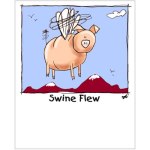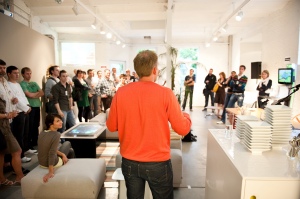 After 2 crazy months I am happy to be at Flanders DC’s Creativity Forum today. All women speakers on the stage today. This morning we already had Randi Zuckerberg, Facebook’s Market Developer (and sister of Mark Zuckerberg) and Jane McGonigal, Game Designer and Futurist. 2 amazingly inspiring speakers.
After 2 crazy months I am happy to be at Flanders DC’s Creativity Forum today. All women speakers on the stage today. This morning we already had Randi Zuckerberg, Facebook’s Market Developer (and sister of Mark Zuckerberg) and Jane McGonigal, Game Designer and Futurist. 2 amazingly inspiring speakers.
Randi Zuckerberg gave some great tips on how to use facebook to get the most out of your brand or company. Facebook is very accessible, it is free and a great tool to create value. Her tips very shortly:
1. Personalise the facebook page of your company or brand.
2. Communicate clearly what your ‘members, visitors’ can expect.
3. Encourage interaction.
4. Be authentic.
5. Give immideate feedback.
6. Use Video !!
7. Let your fans contribute o your facebook page.
8. Be creative with all Facebook’s applications.
9. Encourage viral actions. Let people tag your pictures so they ‘spread’ over facebook.
10. Use the feedback, comments, polls,… for decisions.
And then Jane McGonigal.
The disadvantage when organising an event yourself is that you usually don’t have the time to listen to the speeches yourself. So I was extremely happy to see her again after yesterdays PING conference. She truly is an inspiring leady. Where we usually try to limit the time our children play games she encourages them. Playing games gives players super powers and world changing capabilities in real life. There are 4 kinds of positive emotions people get out of pro-social games:
1. Urgent optimism. Gamers believe to have the skills to actually have problems solved.
2. Social Fabric. We like and trust people more by gaming together.
3. Blissful production. Even people with attention difficulties stay engaged into the hame.
4. Epic meaning. You know what it means to win, how it feels.
These emotions makes super-empowered hopeful individuals. People that can and actually want to do something to make a difference. I really have to start playing games.
Hopefully later today more inspiring talks !
Hybrid meetings
27/04/2010
Last week I attended an information session on Hybrid meetings organised by Abbit Meeting support.
Quite some people think we will see a substantial decrease in organised face to face meetings because some of them will be replaces by virtual ones. That’s perhaps the reason why I think some event organisors fear using or promoting the use of meeting technologies.
I am however convinced that we will see an increase in organised meetings because of the better ROI obtained by using interactive meeting technologies. Online echnology strenghtens the objectives of a face to face meeting, they will rarely replace them.
Face to face meetings and pure virtual meetings are 2 complete different businesses with each their own objectives if you look at them in their pure form. The strongest effect however, is if you use them both. You reach a broader audience and allow your audience to co-create the content of your meeting. Check this interesting presentation from Sam Smith on Building a Digital Game Plan for events:
Don’t you just love Ikea…
18/03/2010
Ikea keeps on surprising the market. Even though they don’t seem to be impacted a lot by the current economic crisis (they keep growing in market share in quite some countries).
 To advertise the opening of a new shop in Japan in 2008 they took over a Japanese subway train and made it their own. The beauty of these IKEA train cars gave the rider a sense of what their own space might look like when they buy IKEA furniture without actually going into the showroom. They just brought their products to their potential customers.
To advertise the opening of a new shop in Japan in 2008 they took over a Japanese subway train and made it their own. The beauty of these IKEA train cars gave the rider a sense of what their own space might look like when they buy IKEA furniture without actually going into the showroom. They just brought their products to their potential customers.
 And currently Ikea has its furniture collections displayed in the busiest subway stations in Paris. They give potential customers a chance to interact with the brand by checking out the products. The subway walls are also filled with prints that showcase IKEA interiors. Moreover, this action completely changes the way the Paris subway station look and creates a cool atmosphere. Imagine waiting for the train in a comfortable sofa! This is certainly the sort of event that people will talk (and blog) of for years to come.
And currently Ikea has its furniture collections displayed in the busiest subway stations in Paris. They give potential customers a chance to interact with the brand by checking out the products. The subway walls are also filled with prints that showcase IKEA interiors. Moreover, this action completely changes the way the Paris subway station look and creates a cool atmosphere. Imagine waiting for the train in a comfortable sofa! This is certainly the sort of event that people will talk (and blog) of for years to come.
I also loved the facebook marketing campaign Ikea launched last year. They used the photo tagging method in a genius way. The shop manager of a new store in Sweden opened a facebook account and posted over a two-week period showroom pictures. Using the tagging—feature people could tag objects in the picture. The first person to tag an item, got it for free ! The word spreaded like crazy on facebook, people started embedding links and pictures in their own profile. In that way they reached thousands of people.
No wonder Ikea is on the top list of dream working places for students.
Sustainable events – are they a myth ?
05/03/2010
We want to create a sustainable event…. that’s the question most meeting and event planners often hear lately. Everybody wants to catch the sustainability train and wants to show this to their audience. But it’s not that simple.
If you want a 100% sustainable event, you better not organise one at all. It is just impossible (even when you organise the event online). As a conference organiser that’s of course not the advice you would like to give to your customers.
On top of this you still want your audience to go home with the same enthusiastic feeling, you still want to create that WAAW feeling, so you don’t want to compromise on that. And usually your customers don’t foresee an extra budget to cover the extra workload coming with that.
So…. I started looking for easy-to-implement sustainability touches: reducing the ecological footprint of the event and keeping an eye on the social context and profit side. There are quite some things you can do with a limited amount of money…and time.
For an offline event, the biggest impact on the ecological footprint of the event is the travel of your audience. So what can you do:
* Stimulate the use of public transportation. This implies of course that you choose your event location accordingly and give people simple directions. Make it easy and attractive. Be creative when shuttles are needed. Why not give a reduction to the event fee, or offer a gift when people used public transportation or other green transportation means.
* Set up a car pool service dedicated for the event. A great positive side effect of this is that you create extra networking opportunities. You can offer carpoolers a parking space closely to the event entrance door.
There are plenty of easy-to-use online tools providing the frame to organise car pooling (some or even completely for free)
In Holland: http://www.Meerijden.nu
In US: Spaceshare.com: for sharing cars, taxis, flights, rooms
In Belgium: http://www.karzoo.be
* Go for 1 single venue and if you really need more, make sure that they are at walking distance. If possible even choose a venue with sleeping facilities for events that last longer then a day.
The biggest problem of catering usually is that we foresee too much food so we throw away too much. Ask people to ‘register’ upfront for meals, just create an extra tick box in your registration form so you have a better estimate of the people actually staying for the networking cocktail or coming early for the welcome coffee.
Give a ring to the local restaurant that serves meals for the homeless that they can pick up the usable leftovers at the end of the day. Some caterers already have this in place.
Keep an eye on the menu choice: choose for local, seasonal and healthy products. If possible also stimulate the caterer to use bio products and fair trade products.
A bit more task consuming: ask for no show penalties. If people didn’t show up, send them an additional invoice with the no show penalty. You can always donate this to charity, then people don’t feel as bad to pay additionally for an event they didn’t even attend. Perhaps you can even consider outsourcing this whole process to the charity organisation.
You can also create a substantial impact when keeping your eye on the communication and promotion of the event. Use as many as possible online tools to promote the event: email, website, newsletters, bannering, social media,…Printed mailings are out ! And if you need to use prints for lets say the signing at the conference or for your programme book, choose your printing office accordingly. Make sure they use environmental friendly ink and paper.

How to keep your eye on the social context, that’s quite easy and I think already commonly done.
* use local suppliers to stimulate local economy (it will also limit the costs of transportation: profit and environment)
* make sure the venue is accessible for disabled people (wheelchairs, blind people,…)
* make sure to use very clear signage that is also visible to people with poor vision
* reserve some place just near the entrance for people with walking difficulties
*…
So there are quite some easy things we can do with little money and little time. I will any how try to keep them in mind for every conference I organise, even if the customer doesn’t specifically ask for this. We all need to contribute and as meeting planners we do have an impact.
If you need some extra inspiration on this topic check:
* http://www.sustainability.events.free.fr, they have a free online guideline book (for music festivals, but you can use plenty of ideas for other kinds of events). They work around the 6 strings of sustainability.
* World Resources Institute — Green Conference: http://www.wri.org/wrisummit/2003_greenconference.html
* http://www.epa.gov/oppt/greenmeetings/index.html
We need more passion
12/01/2010
Creativity is hot these days. We need to be creative in order to respond to quite some challenges today: economic, environmental, social,… It’s true, I am a believer. But what we need first of all is engagement. People that don’t just do what they have to do to earn the money but do what they do because they believe they can make a difference. We need passion, people working towards the same goals. It’s what JCI (Junior Chamber International) calls ‘active citizenship’. Knowledge, creativity, networks are important but passion is the secret ingredient that makes the recipy work. To whom do funders give their money? Which leaders are the most followed and listened to? Indeed…
We are working on stimulating creativity but how can you, as an organisation, as a government stimulate passion and evolve from a knowledge based economy to a ‘passion economy’? Is it something that can be stimulated? I believe so. I can see it whenever we run a good conference or event people leave with the feeling they want to do something with what they have seen, learned or with whom they have met. In Dutch we have a perfect word for this: we give them ‘goesting’ to do something. So how can we see this on a broader scale….and how can you keep on stimulating this?
The 4 hour work week…
06/01/2010
 One of the issues which troubles me most is … I don’t have enough time to do things I want to discover. Ok, I love my job but I think I invest too much of my time into it and combining a business with a family life is not always easy. So I just ordered the book of Tim Ferriss on the 4 hour work week. I hope to get some tips on how to work more efficiently so I can liberate more time to go out and discover… which will eventuely benefit my business and personal life. I’ll get back to you with my feedback !
One of the issues which troubles me most is … I don’t have enough time to do things I want to discover. Ok, I love my job but I think I invest too much of my time into it and combining a business with a family life is not always easy. So I just ordered the book of Tim Ferriss on the 4 hour work week. I hope to get some tips on how to work more efficiently so I can liberate more time to go out and discover… which will eventuely benefit my business and personal life. I’ll get back to you with my feedback !
What viral marketing can do…
05/01/2010
Check out this video. A couple decided to put their wedding video online. The couple together with their family danced down the aisle on the song ‘Forever’ of Chris Brown. It was watched over 37 million times ! Quite a surprise for them as well as they just wanted to share their marriage with their friends and relatives who weren’t there. Because of the controversy regarding Chris Brown, the couple set up a charitable contribution effort on their website for donating funds to end domestic violence. Total donations is already. at $26,802. What a fresh idea can’t do…
external influencers
23/07/2009
 Just as much as the economic crisis has a huge impact on the meeting industry, I fear that we will also see the impact of the mexican (swine) flew in Europe on the industry 2nd half of this year. You can fight the impact of the economic crisis by limiting costs, keeping the tuition fee low, targetting a more local audience,… but can you do so with an epidemic? And isn’t it the perfect reason for not attending an event: crisis + epidemic. The worst impact is still to come…
Just as much as the economic crisis has a huge impact on the meeting industry, I fear that we will also see the impact of the mexican (swine) flew in Europe on the industry 2nd half of this year. You can fight the impact of the economic crisis by limiting costs, keeping the tuition fee low, targetting a more local audience,… but can you do so with an epidemic? And isn’t it the perfect reason for not attending an event: crisis + epidemic. The worst impact is still to come…
inspiring locations in Brussels
09/07/2009
These look like 2 inspiring and totally different locations for smaller events in Brussels:
Plasticarium: plastique est fantastique!
And what about a meeting or reception in an antique store … Costermans antiek.

So if you are location hunting, don’t always look at the traditional meeting facilities, there are plenty of alternatives, as long as your group is not too big. A great example of such an event was the user experience roadshow of Microsoft @ 3 different Vitra shops in the country.

Generation Y…
24/06/2009
 …does not want to hear what they can find on the internet! We want to make a difference. We like infotainment, edutainment, involvement, green, we don’t like boring speakers and long speeches (our attention span is just not long enough). Rob Davidson did some research on what the generation Y (born 1977 and later) is looking for in meetings and conferences. As I am born in 1978, I read the article with much interest and honoustly…he’s right! We are the first indepentent generation ever (mom and dad went both out working), the first global generation and the first internet generation. We are building the bridge to generation Z (born after 2013), they will grow up in a highly sophisticated media and computer environment. This has a significant impact on the way meetings and conferences need to be done in the future. Face it, your audience will in the very near future consist mainly of generation Y people….take this into account!
…does not want to hear what they can find on the internet! We want to make a difference. We like infotainment, edutainment, involvement, green, we don’t like boring speakers and long speeches (our attention span is just not long enough). Rob Davidson did some research on what the generation Y (born 1977 and later) is looking for in meetings and conferences. As I am born in 1978, I read the article with much interest and honoustly…he’s right! We are the first indepentent generation ever (mom and dad went both out working), the first global generation and the first internet generation. We are building the bridge to generation Z (born after 2013), they will grow up in a highly sophisticated media and computer environment. This has a significant impact on the way meetings and conferences need to be done in the future. Face it, your audience will in the very near future consist mainly of generation Y people….take this into account!



